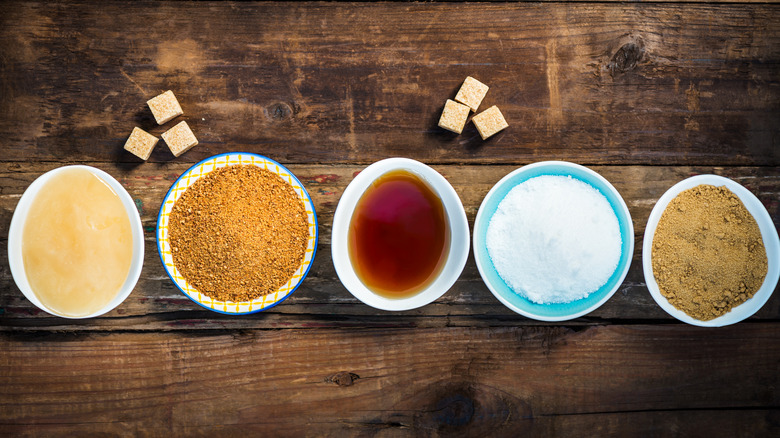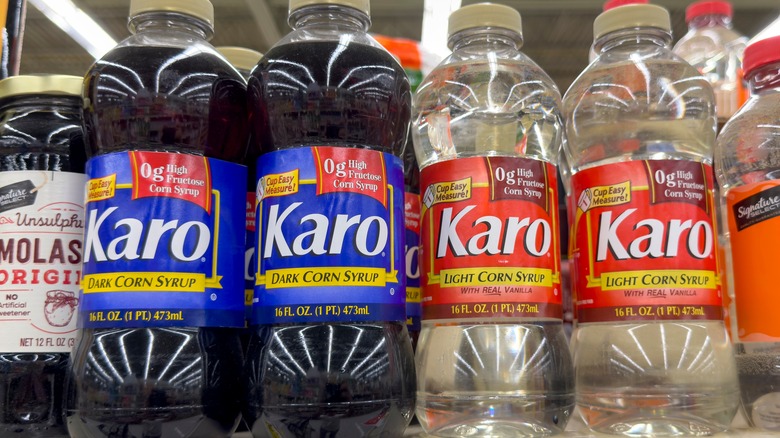Cane Sugar Vs High Fructose Corn Syrup: What's The Difference?
Just glance at grocery store aisles and the prominent role of sweeteners becomes evident. From the many kinds of bulk sugars for sale, to the world of diet sodas, and the unsuspecting sweeteners hiding in foods like breads or even salad dressing, it's an ingredient that defines the modern era.
And when such variety meets ubiquity, navigating all the types turns tricky. Take cane sugar and high fructose corn syrup (often abbreviated HFCS). The former is a pantry staple, composed of relatively refined sugar crystals. Meanwhile, high fructose corn syrup is a clear industrial product that carries negative associations.
Yet although distinct in production, texture, flavor, and culinary usage, the two foodstuffs are incredibly similar in their chemical makeup. Once incorporated into foods and consumed, the distinction essentially comes down to flavor and texture. So to pinpoint their role in cooking — as well as assess their nutritional effects — it pays off to untangle the nuance between the two compounds.
Cane sugar is a complex, versatile sweetener
Amidst varying sweeteners, cane sugar arises from a relatively straightforward process. The foodstuff's sourced only from sugarcane — the tall, stalky grass that creates diverse products like syrupy molasses, fruity sugarcane juice, and rum. Cane sugar is produced by crushing sugarcane stalks to extract juice, which is then purified and boiled to form sugar crystals. A centrifuge is then used to separate the solid sugar from the liquid molasses.
As you'd expect with such light-handed processing, the resultant grains can vary in size and may still maintain a dark hue, which is why some types of cane sugar are considered less refined than white granulated sugar. And when compared to the completely clear and liquid high fructose corn syrup, their physical properties are immediately distinguishable.
Zoom into the foodstuff's molecular composition, and cane sugar comes out to approximately equal parts glucose and fructose — similar to high fructose corn syrup, which ranges from 42% to 55% fructose. It's the high fructose content of both sweeteners that presents health risks, especially taking a toll on the liver. So when investigating nutritional value, cane sugar and HFCS carry similar health risks.
Culinarily, cane sugar presents some unique advantages over corn syrup. Liquefied into a syrup, it translates more of molasses' flavor, adding an additional layer of complexity to lemonades, soft drinks, and cocktails. Meanwhile, kept solid, its coarser texture and darker tinge can add unique character to baked goods. Ultimately, cane sugar's distinction lies in how it performs in the kitchen.
High fructose corn syrup is more industrial in nature
Opposed to cane sugar's robust character, high fructose corn syrup's neutrality has cemented it as an industrial go-to. Its dependable sweetness, uniform consistency, and low cost make it easy to incorporate into everything from ice cream, to juices, jams, candies, sodas, and even savory items like barbecue sauce. While not often used by home cooks, such standardized malleability makes it a modern fixture.
The foodstuff's creation follows an intricate industrial process. High fructose corn syrup starts with transforming corn starch into a liquid that's exclusively glucose. A further round of enzyme treatment then separates standard corn syrup from high fructose corn syrup. The increased quantity of fructose also ups the sweetness of the product, even more than other naturally derived sugars. Manufacturers produce syrups with varying amounts of fructose, some less than cane sugar, others more — a built-in flexibility that has become an advantage of the product.
An abundance of health concern surrounds the ingredient, largely due to its prevalence. Nevertheless, according to the U.S. Food and Drug Administration, there are no dangers specific to HFCS compared to naturally derived sweeteners with the same composition of fructose. So while cane sugar is typically employed at home and HFCS is encountered in processed products, it's most critical to keep an eye on overall fructose consumption.



